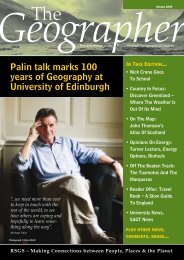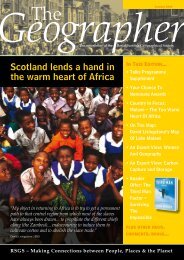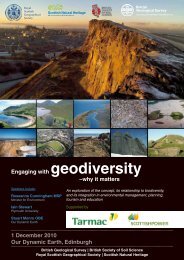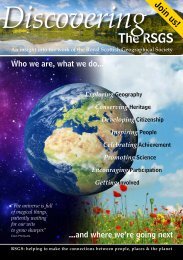Geographer - Royal Scottish Geographical Society
Geographer - Royal Scottish Geographical Society
Geographer - Royal Scottish Geographical Society
Create successful ePaper yourself
Turn your PDF publications into a flip-book with our unique Google optimized e-Paper software.
Education<br />
Orang-utan research project<br />
Graham L Banes<br />
“In 2008, the <strong>Society</strong> took a ‘leap of<br />
faith’ and made a small grant to fund<br />
our expedition: by June of that year,<br />
Orang-utan ’08 was in full swing.”<br />
Main shot:<br />
Kusasi is the<br />
dominant male<br />
orang-utan.<br />
An orang-utan<br />
welcomes us to<br />
Tanjung Puting<br />
National Park.<br />
Counting ‘nests’<br />
involved looking<br />
up at the tree<br />
and trying to<br />
distinguish<br />
the sleeping<br />
platforms from<br />
the foliage<br />
surrounding<br />
them. When a<br />
tree contained a<br />
nest, we tagged it<br />
with bright-orange<br />
tape to facilitate<br />
re-counts and<br />
prevent us from<br />
counting the<br />
same nest twice.<br />
All travel within<br />
the Park,<br />
including along<br />
the crocodileinfested<br />
Sekonyer<br />
river, was by<br />
kelotok, a sort<br />
of motorised<br />
longboat; here,<br />
local children<br />
watch us load up.<br />
An infant orangutan.<br />
The Bornean orang-utan is an<br />
endangered species endemic<br />
to the island of Borneo, where<br />
less than 54,000 individuals are<br />
thought to remain in a small<br />
number of wild populations. Of<br />
all species, they are among the<br />
most closely-related to humans –<br />
we share 96.5% of our DNA with<br />
orang-utans and their name, from<br />
Malay, even translates to ‘person<br />
of the forest’. Despite<br />
this, we do little to<br />
respect our arboreal<br />
kin: orang-utans<br />
are continually<br />
threatened by<br />
habitat loss,<br />
hunting and the<br />
pet trade. More<br />
than 90% of<br />
original orang-utan<br />
habitat is thought to<br />
have already been<br />
destroyed.<br />
My intention to study orangutans<br />
was realised at the<br />
University of Aberdeen, while<br />
reading my Bachelor’s degree in<br />
Zoology. When given the option<br />
of writing a ‘standard’ thesis or<br />
going further afield to collect<br />
primary data, I opted to head<br />
for Indonesia to study orangutans<br />
in the wild. I was fortunate<br />
to receive ample support from<br />
academic staff, notably Dr David<br />
Burslem and Prof Paul Racey,<br />
who encouraged me to plan<br />
an expedition and to recruit<br />
three fellow students to assist<br />
in data collection. Procuring<br />
financial support was rather<br />
more difficult, however. Despite<br />
having spent months planning<br />
a sound expedition, and despite<br />
having gained approval from the<br />
Indonesian authorities, we were<br />
turned down by innumerable<br />
funding organisations. Nobody<br />
wanted to fund undergraduate<br />
students, especially those who<br />
had no experience of field work<br />
and who had never seen orangutans<br />
outside of the zoo.<br />
An orang-utan and I sit<br />
companionably around a tree.<br />
The RSGS was a notable<br />
exception. In 2008, the <strong>Society</strong><br />
took a ‘leap of faith’ and made<br />
a small grant to fund our<br />
expedition: by June of that year,<br />
Orang-utan ’08 was in full swing.<br />
Over five months, we conducted<br />
line-transect surveys of orangutan<br />
sleeping platforms to<br />
determine population density in<br />
Tanjung Puting National Park,<br />
Central Kalimantan. Our<br />
study was the first to<br />
assess the orangutan<br />
population<br />
in Tanjung Puting<br />
since 2003 and was<br />
the first to conduct<br />
line-transect surveys<br />
at primary peatswamp<br />
forest sites. We<br />
determined Tanjung<br />
Puting to harbour up<br />
to 9,000 orang-utans, rendering<br />
it home to the world’s largest<br />
orang-utan population. We also<br />
found that the orang-utans there<br />
could adapt well in the long term<br />
following logging, once forest<br />
has been left to recover. Notably,<br />
we observed no evidence of<br />
orang-utans in sites disturbed<br />
by fire, concluding that efforts to<br />
safeguard Tanjung Puting should<br />
remain a conservation priority.<br />
I remain eternally grateful to<br />
the RSGS: our expedition would<br />
not have been possible without<br />
the support and encouragement<br />
of the <strong>Society</strong>’s board and<br />
members. However, our research<br />
doesn’t end here: I remain<br />
committed to the orang-utans of<br />
Tanjung Puting and now continue<br />
my work at the University of<br />
Cambridge. Please visit our<br />
website (www.prime.bioanth.<br />
cam.ac.uk/graham) to read more<br />
about our orang-utan research<br />
programme, funded in part by<br />
the RSGS.








